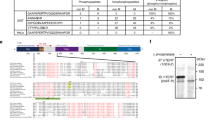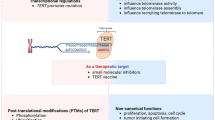Abstract
Upregulation of human telomerase reverse transcriptase (hTERT) transcription accounts for the immortalization of greater than 85% of all human tumor cells. However, the mechanism whereby hTERT expression is activated remains unresolved. Specifically, recent data challenging the role of Myc/Max in E-box-dependent activation of hTERT expression suggests that other E-box-binding proteins regulate hTERT transcription. Indeed, we now demonstrate that two such proteins, upstream stimulatory factor (USF) 1 and 2, readily associate with two E-boxes in the hTERT promoter in vitro and in vivo primarily as heterodimers, whereas Myc/Max does not. The avid binding of USF1/2 heterodimers to these E-boxes occurs in both hTERT-positive and -negative cells. In contrast, USF1/2 activates the hTERT promoter exclusively in hTERT-positive cells in a manner that is enhanced by the coactivator p300 and attenuated upon inhibiting p38-MAP kinase, a known modulator of USF activity. Collectively, our data indicate that USF binding to the hTERT promoter may be transcriptionally neutral, or even repressive, in nonimmortalized hTERT-negative somatic cells, but stimulatory in hTERT-positive cells where USF1/2 contributes to the acquisition and maintenance of immortality.
This is a preview of subscription content, access via your institution
Access options
Subscribe to this journal
Receive 50 print issues and online access
$259.00 per year
only $5.18 per issue
Buy this article
- Purchase on Springer Link
- Instant access to full article PDF
Prices may be subject to local taxes which are calculated during checkout




Similar content being viewed by others
References
Aisner DL, Wright WE and Shay JW . (2002). Curr. Opin. Genet. Dev., 12, 80–85.
Blackburn EH . (2001). Cell, 106, 661–673.
Bosc DG, Goueli BS and Janknecht R . (2001). Oncogene, 20, 6215–6224.
Bredemeier-Ernst I, Nordheim A and Janknecht R . (1997). FEBS Lett., 408, 47–51.
Breen GA and Jordan EM . (1999). Biochim. Biophys. Acta, 1428, 169–176.
Dhaene K, Wauters J, Weyn B, Timmermans JP and van Marck E . (2000). J. Pathol., 190, 80–85.
Dillner NB and Sanders MM . (2002). J. Biol. Chem., 277, 33890–33894.
Drissi R, Zindy F, Roussel MF and Cleveland JL . (2001). J. Biol. Chem., 276, 29994–30001.
Ducrest AL, Amacker M, Mathieu YD, Cuthbert AP, Trott DA, Newbold RF, Nabholz M and Lingner J . (2001). Cancer Res., 61, 7594–7602.
Ducrest AL, Szutorisz H, Lingner J and Nabholz M . (2002). Oncogene, 21, 541–552.
Galibert MD, Carreira S and Goding CR . (2001). EMBO J., 20, 5022–5031.
Goodman RH and Smolik S . (2000). Genes Dev., 14, 1553–1577.
Gregor PD, Sawadogo M and Roeder RG . (1990). Genes Dev., 4, 1730–1740.
Heckert LL . (2001). Mol. Endocrinol., 15, 704–715.
Hiyama E and Hiyama K . (2002). Oncogene, 21, 643–649.
Horikawa I, Cable PL, Mazur SJ, Appella E, Afshari CA and Barrett JC . (2002). Mol. Biol. Cell, 13, 2585–2597.
Horiuchi K, Fujimoto D, Fukushima M and Kanai K . (1981). Cancer Res., 41, 1488–1491.
Janknecht R . (2002). Histol. Histopathol., 17, 657–668.
Kumari D and Usdin K . (2001). J. Biol. Chem., 276, 4357–4364.
Kuo MH and Allis CD . (1999). Methods, 19, 425–433.
Kyo S, Takakura M, Taira T, Kanaya T, Itoh H, Yutsudo M, Ariga H and Inoue M . (2000). Nucleic Acids Res., 28, 669–677.
Lee JC, Laydon JT, McDonnell PC, Gallagher TF, Kumar S, Green D, McNulty D, Blumenthal MJ, Heys JR, Landvatter SW, Strickler JE, McLaughlin MM, Siemens IR, Fisher SM, Livi GP, White JR, Adams JL and Young PR . (1994). Nature, 372, 739–746.
Liu SL, Rand A, Kelm Jr RJ and Getz MJ . (2000). Oncogene, 19, 3352–3362.
Muhlethaler-Mottet A, Di Berardino W, Otten LA and Mach B . (1998). Immunity, 8, 157–166.
Pearson KL, Hunter T and Janknecht R . (1999). Biochim. Biophys. Acta, 1489, 354–364.
Poole JC, Andrews LG and Tollefsbol TO . (2001). Gene, 269, 1–12.
Sirito M, Lin Q, Maity T and Sawadogo M . (1994). Nucleic Acids Res., 22, 427–433.
Sirito M, Walker S, Lin Q, Kozlowski MT, Klein WH and Sawadogo M . (1992). Gene Expr., 2, 231–240.
Viollet B, Lefrancois-Martinez AM, Henrion A, Kahn A, Raymondjean M and Martinez A . (1996). J. Biol. Chem., 271, 1405–1415.
Won J, Yim J and Kim TK . (2002a). FASEB J., 16, 1943–1945.
Won J, Yim J and Kim TK . (2002b). J. Biol. Chem., 277, 38230–38238.
Yago M, Ohki R, Hatakeyama S, Fujita T and Ishikawa F . (2002). FEBS Lett., 520, 40–46.
Author information
Authors and Affiliations
Corresponding author
Rights and permissions
About this article
Cite this article
Goueli, B., Janknecht, R. Regulation of telomerase reverse transcriptase gene activity by upstream stimulatory factor. Oncogene 22, 8042–8047 (2003). https://doi.org/10.1038/sj.onc.1206847
Received:
Revised:
Accepted:
Published:
Issue Date:
DOI: https://doi.org/10.1038/sj.onc.1206847
Keywords
This article is cited by
-
Regulation of human telomerase in homeostasis and disease
Nature Reviews Molecular Cell Biology (2020)
-
RIF1 promotes human epithelial ovarian cancer growth and progression via activating human telomerase reverse transcriptase expression
Journal of Experimental & Clinical Cancer Research (2018)
-
hTERT promoter methylation status in peripheral blood leukocytes as a molecular marker of head and neck cancer progression
Journal of Applied Genetics (2018)
-
Keratin 23 promotes telomerase reverse transcriptase expression and human colorectal cancer growth
Cell Death & Disease (2017)
-
Regulation of human and mouse telomerase genes by genomic contexts and transcription factors during embryonic stem cell differentiation
Scientific Reports (2017)



